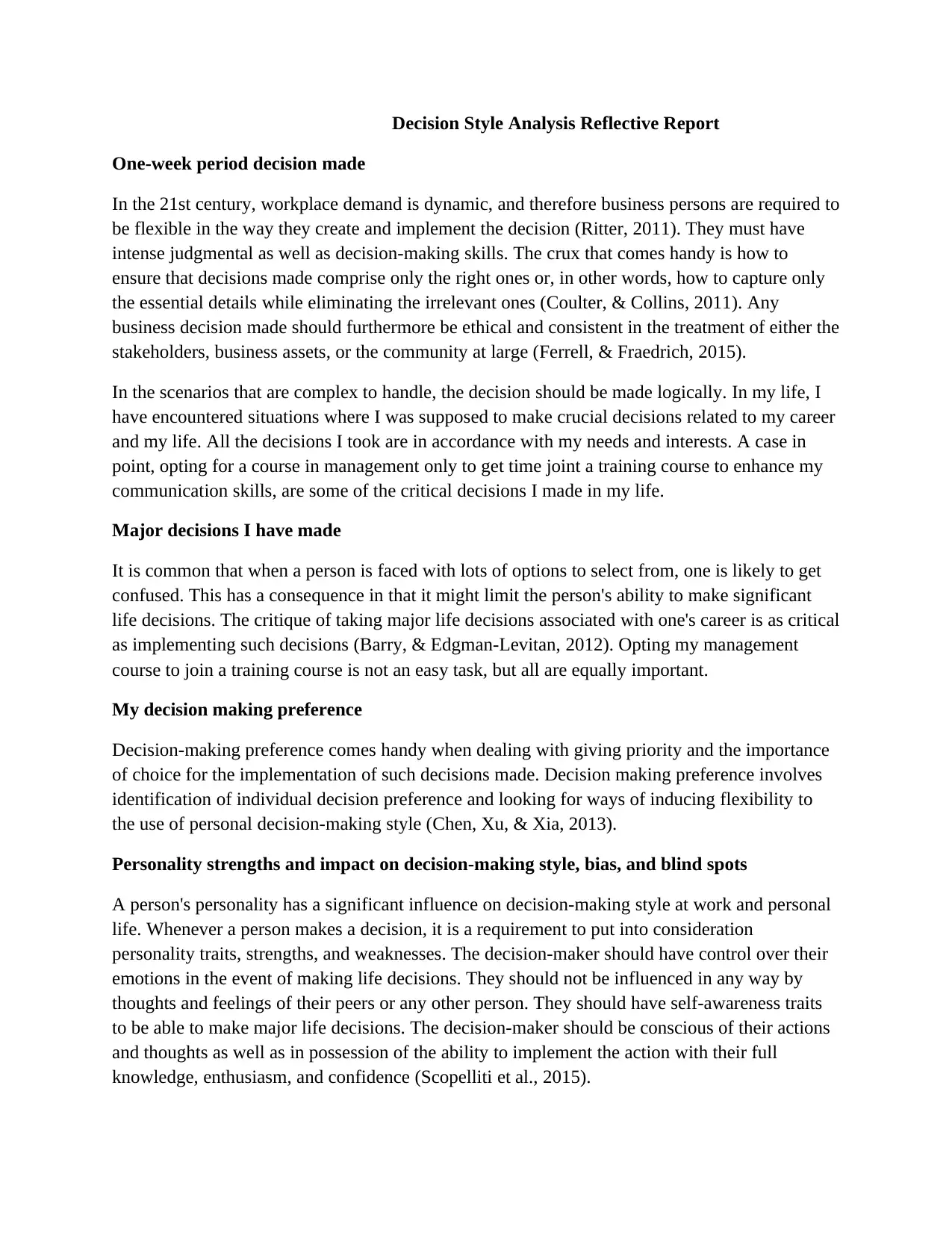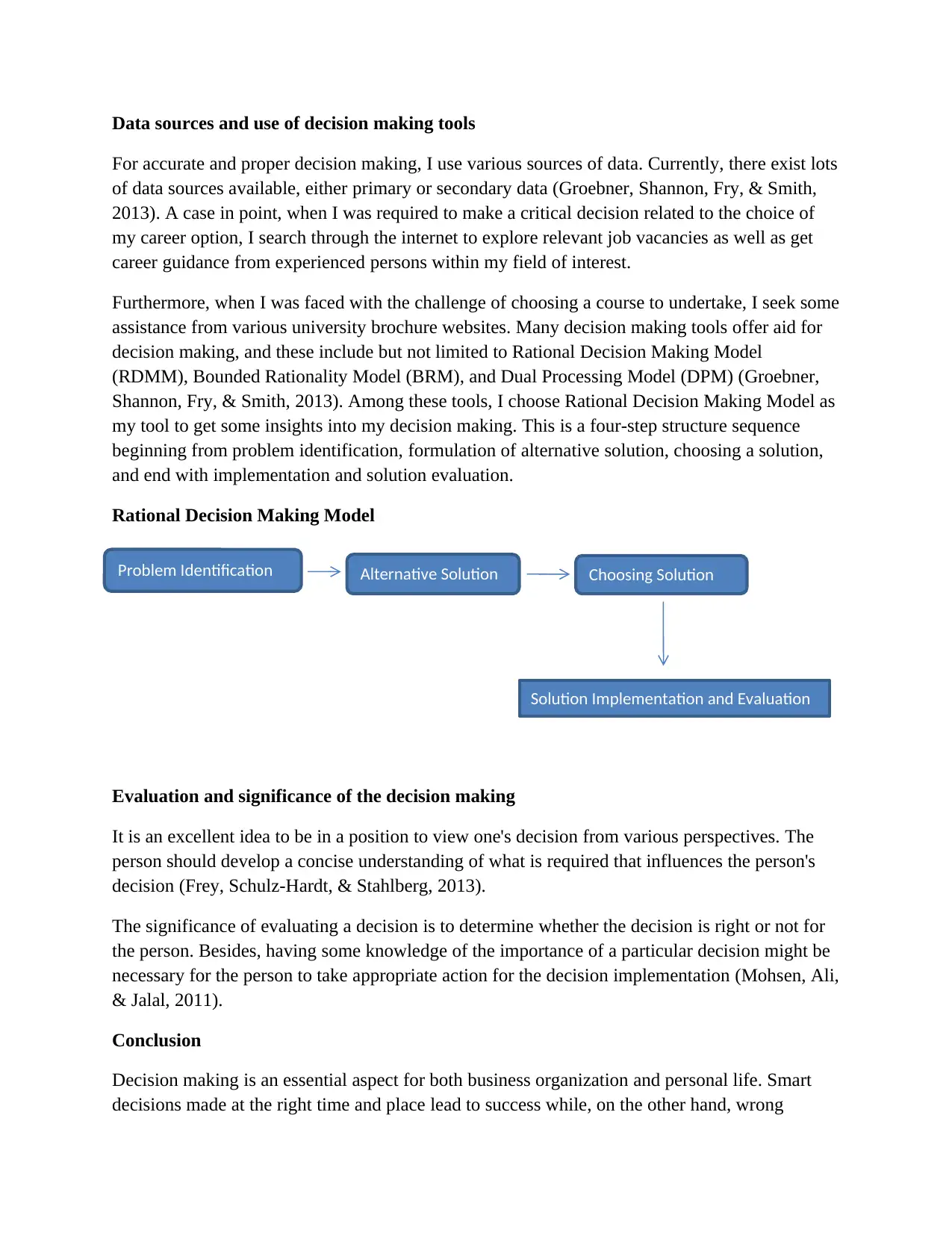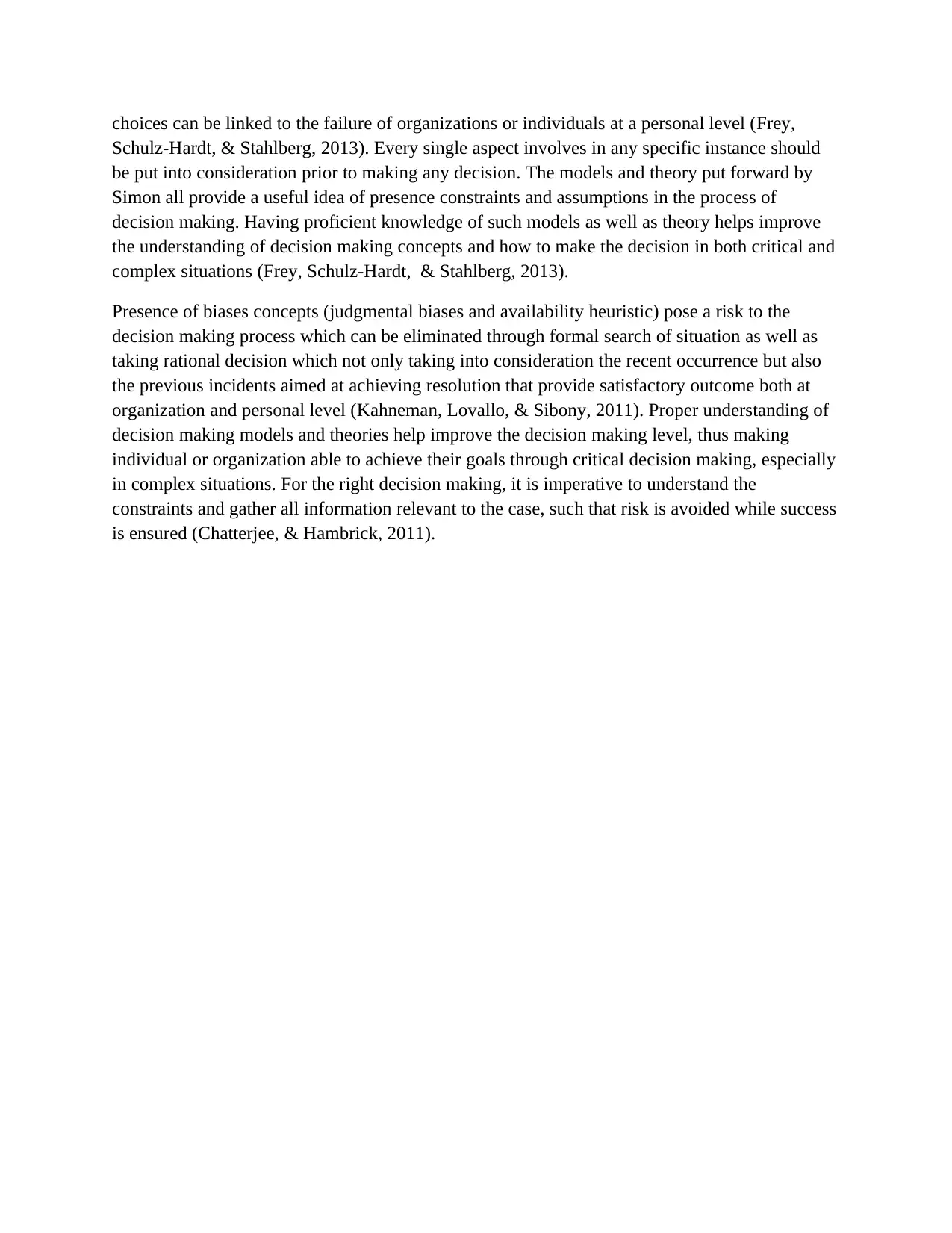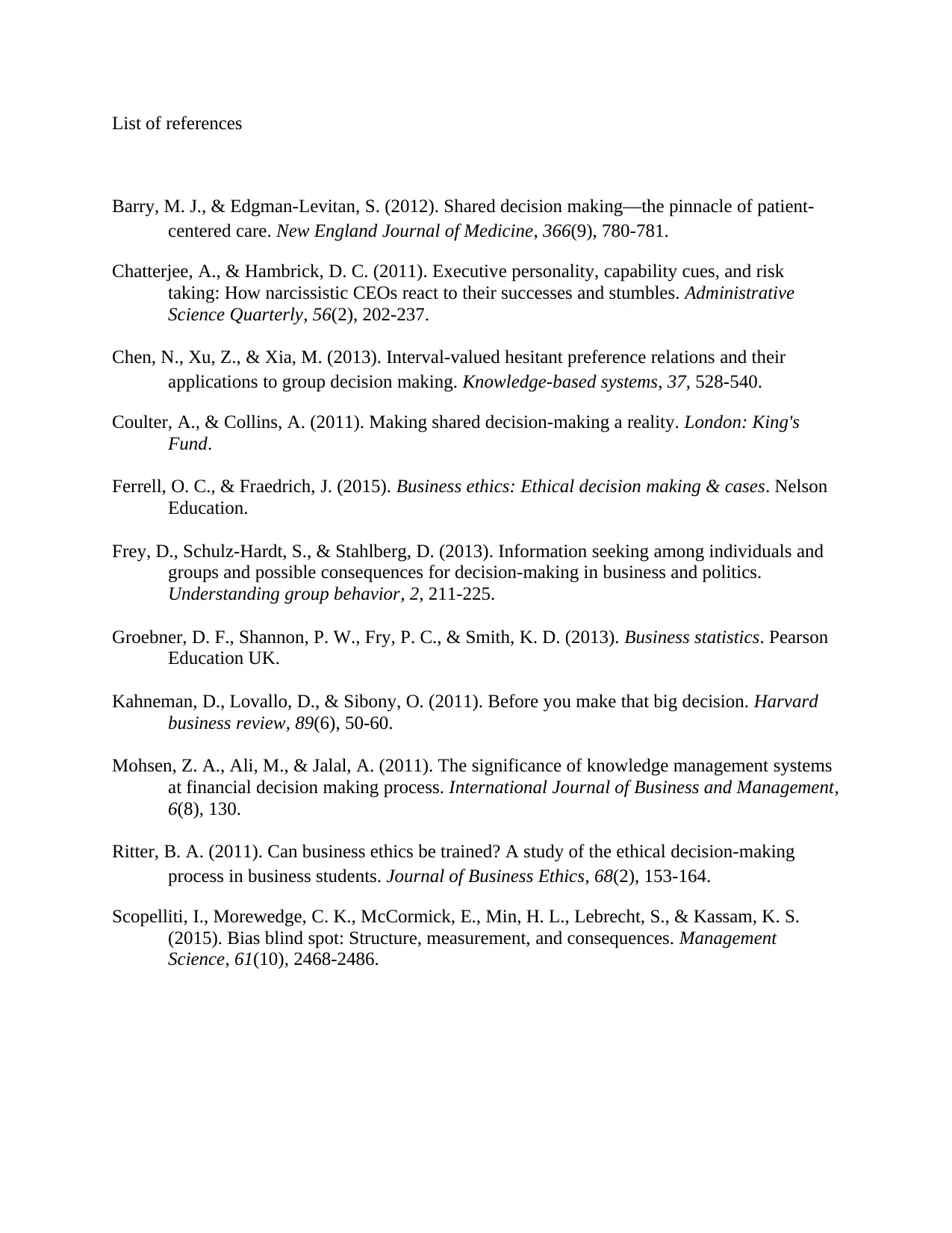Decision Style Analysis Reflective Report for MGT602, Week 2, Analysis
VerifiedAdded on 2022/09/07
|4
|1587
|33
Report
AI Summary
This reflective report analyzes decision-making styles and processes, focusing on personal preferences and the application of various decision-making tools. The report examines the importance of flexibility and judgment in modern workplaces, emphasizing the need to filter relevant information and make ethical decisions. It explores the author's personal experiences, including career and training course choices, and details the decision-making preferences and personality traits that influence these choices. The Rational Decision Making Model is identified as a key tool, and the report discusses the use of data sources and the evaluation of decision-making outcomes. The author concludes by highlighting the significance of understanding decision-making models and theories to improve decision-making skills, especially in complex situations, and to avoid biases. The references include various academic sources related to decision-making, business ethics, and strategic management.

Decision Style Analysis Reflective Report
One-week period decision made
In the 21st century, workplace demand is dynamic, and therefore business persons are required to
be flexible in the way they create and implement the decision (Ritter, 2011). They must have
intense judgmental as well as decision-making skills. The crux that comes handy is how to
ensure that decisions made comprise only the right ones or, in other words, how to capture only
the essential details while eliminating the irrelevant ones (Coulter, & Collins, 2011). Any
business decision made should furthermore be ethical and consistent in the treatment of either the
stakeholders, business assets, or the community at large (Ferrell, & Fraedrich, 2015).
In the scenarios that are complex to handle, the decision should be made logically. In my life, I
have encountered situations where I was supposed to make crucial decisions related to my career
and my life. All the decisions I took are in accordance with my needs and interests. A case in
point, opting for a course in management only to get time joint a training course to enhance my
communication skills, are some of the critical decisions I made in my life.
Major decisions I have made
It is common that when a person is faced with lots of options to select from, one is likely to get
confused. This has a consequence in that it might limit the person's ability to make significant
life decisions. The critique of taking major life decisions associated with one's career is as critical
as implementing such decisions (Barry, & Edgman-Levitan, 2012). Opting my management
course to join a training course is not an easy task, but all are equally important.
My decision making preference
Decision-making preference comes handy when dealing with giving priority and the importance
of choice for the implementation of such decisions made. Decision making preference involves
identification of individual decision preference and looking for ways of inducing flexibility to
the use of personal decision-making style (Chen, Xu, & Xia, 2013).
Personality strengths and impact on decision-making style, bias, and blind spots
A person's personality has a significant influence on decision-making style at work and personal
life. Whenever a person makes a decision, it is a requirement to put into consideration
personality traits, strengths, and weaknesses. The decision-maker should have control over their
emotions in the event of making life decisions. They should not be influenced in any way by
thoughts and feelings of their peers or any other person. They should have self-awareness traits
to be able to make major life decisions. The decision-maker should be conscious of their actions
and thoughts as well as in possession of the ability to implement the action with their full
knowledge, enthusiasm, and confidence (Scopelliti et al., 2015).
One-week period decision made
In the 21st century, workplace demand is dynamic, and therefore business persons are required to
be flexible in the way they create and implement the decision (Ritter, 2011). They must have
intense judgmental as well as decision-making skills. The crux that comes handy is how to
ensure that decisions made comprise only the right ones or, in other words, how to capture only
the essential details while eliminating the irrelevant ones (Coulter, & Collins, 2011). Any
business decision made should furthermore be ethical and consistent in the treatment of either the
stakeholders, business assets, or the community at large (Ferrell, & Fraedrich, 2015).
In the scenarios that are complex to handle, the decision should be made logically. In my life, I
have encountered situations where I was supposed to make crucial decisions related to my career
and my life. All the decisions I took are in accordance with my needs and interests. A case in
point, opting for a course in management only to get time joint a training course to enhance my
communication skills, are some of the critical decisions I made in my life.
Major decisions I have made
It is common that when a person is faced with lots of options to select from, one is likely to get
confused. This has a consequence in that it might limit the person's ability to make significant
life decisions. The critique of taking major life decisions associated with one's career is as critical
as implementing such decisions (Barry, & Edgman-Levitan, 2012). Opting my management
course to join a training course is not an easy task, but all are equally important.
My decision making preference
Decision-making preference comes handy when dealing with giving priority and the importance
of choice for the implementation of such decisions made. Decision making preference involves
identification of individual decision preference and looking for ways of inducing flexibility to
the use of personal decision-making style (Chen, Xu, & Xia, 2013).
Personality strengths and impact on decision-making style, bias, and blind spots
A person's personality has a significant influence on decision-making style at work and personal
life. Whenever a person makes a decision, it is a requirement to put into consideration
personality traits, strengths, and weaknesses. The decision-maker should have control over their
emotions in the event of making life decisions. They should not be influenced in any way by
thoughts and feelings of their peers or any other person. They should have self-awareness traits
to be able to make major life decisions. The decision-maker should be conscious of their actions
and thoughts as well as in possession of the ability to implement the action with their full
knowledge, enthusiasm, and confidence (Scopelliti et al., 2015).
Paraphrase This Document
Need a fresh take? Get an instant paraphrase of this document with our AI Paraphraser

Data sources and use of decision making tools
For accurate and proper decision making, I use various sources of data. Currently, there exist lots
of data sources available, either primary or secondary data (Groebner, Shannon, Fry, & Smith,
2013). A case in point, when I was required to make a critical decision related to the choice of
my career option, I search through the internet to explore relevant job vacancies as well as get
career guidance from experienced persons within my field of interest.
Furthermore, when I was faced with the challenge of choosing a course to undertake, I seek some
assistance from various university brochure websites. Many decision making tools offer aid for
decision making, and these include but not limited to Rational Decision Making Model
(RDMM), Bounded Rationality Model (BRM), and Dual Processing Model (DPM) (Groebner,
Shannon, Fry, & Smith, 2013). Among these tools, I choose Rational Decision Making Model as
my tool to get some insights into my decision making. This is a four-step structure sequence
beginning from problem identification, formulation of alternative solution, choosing a solution,
and end with implementation and solution evaluation.
Rational Decision Making Model
Evaluation and significance of the decision making
It is an excellent idea to be in a position to view one's decision from various perspectives. The
person should develop a concise understanding of what is required that influences the person's
decision (Frey, Schulz-Hardt, & Stahlberg, 2013).
The significance of evaluating a decision is to determine whether the decision is right or not for
the person. Besides, having some knowledge of the importance of a particular decision might be
necessary for the person to take appropriate action for the decision implementation (Mohsen, Ali,
& Jalal, 2011).
Conclusion
Decision making is an essential aspect for both business organization and personal life. Smart
decisions made at the right time and place lead to success while, on the other hand, wrong
Problem Identification Alternative Solution Choosing Solution
Solution Implementation and Evaluation
For accurate and proper decision making, I use various sources of data. Currently, there exist lots
of data sources available, either primary or secondary data (Groebner, Shannon, Fry, & Smith,
2013). A case in point, when I was required to make a critical decision related to the choice of
my career option, I search through the internet to explore relevant job vacancies as well as get
career guidance from experienced persons within my field of interest.
Furthermore, when I was faced with the challenge of choosing a course to undertake, I seek some
assistance from various university brochure websites. Many decision making tools offer aid for
decision making, and these include but not limited to Rational Decision Making Model
(RDMM), Bounded Rationality Model (BRM), and Dual Processing Model (DPM) (Groebner,
Shannon, Fry, & Smith, 2013). Among these tools, I choose Rational Decision Making Model as
my tool to get some insights into my decision making. This is a four-step structure sequence
beginning from problem identification, formulation of alternative solution, choosing a solution,
and end with implementation and solution evaluation.
Rational Decision Making Model
Evaluation and significance of the decision making
It is an excellent idea to be in a position to view one's decision from various perspectives. The
person should develop a concise understanding of what is required that influences the person's
decision (Frey, Schulz-Hardt, & Stahlberg, 2013).
The significance of evaluating a decision is to determine whether the decision is right or not for
the person. Besides, having some knowledge of the importance of a particular decision might be
necessary for the person to take appropriate action for the decision implementation (Mohsen, Ali,
& Jalal, 2011).
Conclusion
Decision making is an essential aspect for both business organization and personal life. Smart
decisions made at the right time and place lead to success while, on the other hand, wrong
Problem Identification Alternative Solution Choosing Solution
Solution Implementation and Evaluation

choices can be linked to the failure of organizations or individuals at a personal level (Frey,
Schulz-Hardt, & Stahlberg, 2013). Every single aspect involves in any specific instance should
be put into consideration prior to making any decision. The models and theory put forward by
Simon all provide a useful idea of presence constraints and assumptions in the process of
decision making. Having proficient knowledge of such models as well as theory helps improve
the understanding of decision making concepts and how to make the decision in both critical and
complex situations (Frey, Schulz-Hardt, & Stahlberg, 2013).
Presence of biases concepts (judgmental biases and availability heuristic) pose a risk to the
decision making process which can be eliminated through formal search of situation as well as
taking rational decision which not only taking into consideration the recent occurrence but also
the previous incidents aimed at achieving resolution that provide satisfactory outcome both at
organization and personal level (Kahneman, Lovallo, & Sibony, 2011). Proper understanding of
decision making models and theories help improve the decision making level, thus making
individual or organization able to achieve their goals through critical decision making, especially
in complex situations. For the right decision making, it is imperative to understand the
constraints and gather all information relevant to the case, such that risk is avoided while success
is ensured (Chatterjee, & Hambrick, 2011).
Schulz-Hardt, & Stahlberg, 2013). Every single aspect involves in any specific instance should
be put into consideration prior to making any decision. The models and theory put forward by
Simon all provide a useful idea of presence constraints and assumptions in the process of
decision making. Having proficient knowledge of such models as well as theory helps improve
the understanding of decision making concepts and how to make the decision in both critical and
complex situations (Frey, Schulz-Hardt, & Stahlberg, 2013).
Presence of biases concepts (judgmental biases and availability heuristic) pose a risk to the
decision making process which can be eliminated through formal search of situation as well as
taking rational decision which not only taking into consideration the recent occurrence but also
the previous incidents aimed at achieving resolution that provide satisfactory outcome both at
organization and personal level (Kahneman, Lovallo, & Sibony, 2011). Proper understanding of
decision making models and theories help improve the decision making level, thus making
individual or organization able to achieve their goals through critical decision making, especially
in complex situations. For the right decision making, it is imperative to understand the
constraints and gather all information relevant to the case, such that risk is avoided while success
is ensured (Chatterjee, & Hambrick, 2011).
⊘ This is a preview!⊘
Do you want full access?
Subscribe today to unlock all pages.

Trusted by 1+ million students worldwide

List of references
Barry, M. J., & Edgman-Levitan, S. (2012). Shared decision making—the pinnacle of patient-
centered care. New England Journal of Medicine, 366(9), 780-781.
Chatterjee, A., & Hambrick, D. C. (2011). Executive personality, capability cues, and risk
taking: How narcissistic CEOs react to their successes and stumbles. Administrative
Science Quarterly, 56(2), 202-237.
Chen, N., Xu, Z., & Xia, M. (2013). Interval-valued hesitant preference relations and their
applications to group decision making. Knowledge-based systems, 37, 528-540.
Coulter, A., & Collins, A. (2011). Making shared decision-making a reality. London: King's
Fund.
Ferrell, O. C., & Fraedrich, J. (2015). Business ethics: Ethical decision making & cases. Nelson
Education.
Frey, D., Schulz-Hardt, S., & Stahlberg, D. (2013). Information seeking among individuals and
groups and possible consequences for decision-making in business and politics.
Understanding group behavior, 2, 211-225.
Groebner, D. F., Shannon, P. W., Fry, P. C., & Smith, K. D. (2013). Business statistics. Pearson
Education UK.
Kahneman, D., Lovallo, D., & Sibony, O. (2011). Before you make that big decision. Harvard
business review, 89(6), 50-60.
Mohsen, Z. A., Ali, M., & Jalal, A. (2011). The significance of knowledge management systems
at financial decision making process. International Journal of Business and Management,
6(8), 130.
Ritter, B. A. (2011). Can business ethics be trained? A study of the ethical decision-making
process in business students. Journal of Business Ethics, 68(2), 153-164.
Scopelliti, I., Morewedge, C. K., McCormick, E., Min, H. L., Lebrecht, S., & Kassam, K. S.
(2015). Bias blind spot: Structure, measurement, and consequences. Management
Science, 61(10), 2468-2486.
Barry, M. J., & Edgman-Levitan, S. (2012). Shared decision making—the pinnacle of patient-
centered care. New England Journal of Medicine, 366(9), 780-781.
Chatterjee, A., & Hambrick, D. C. (2011). Executive personality, capability cues, and risk
taking: How narcissistic CEOs react to their successes and stumbles. Administrative
Science Quarterly, 56(2), 202-237.
Chen, N., Xu, Z., & Xia, M. (2013). Interval-valued hesitant preference relations and their
applications to group decision making. Knowledge-based systems, 37, 528-540.
Coulter, A., & Collins, A. (2011). Making shared decision-making a reality. London: King's
Fund.
Ferrell, O. C., & Fraedrich, J. (2015). Business ethics: Ethical decision making & cases. Nelson
Education.
Frey, D., Schulz-Hardt, S., & Stahlberg, D. (2013). Information seeking among individuals and
groups and possible consequences for decision-making in business and politics.
Understanding group behavior, 2, 211-225.
Groebner, D. F., Shannon, P. W., Fry, P. C., & Smith, K. D. (2013). Business statistics. Pearson
Education UK.
Kahneman, D., Lovallo, D., & Sibony, O. (2011). Before you make that big decision. Harvard
business review, 89(6), 50-60.
Mohsen, Z. A., Ali, M., & Jalal, A. (2011). The significance of knowledge management systems
at financial decision making process. International Journal of Business and Management,
6(8), 130.
Ritter, B. A. (2011). Can business ethics be trained? A study of the ethical decision-making
process in business students. Journal of Business Ethics, 68(2), 153-164.
Scopelliti, I., Morewedge, C. K., McCormick, E., Min, H. L., Lebrecht, S., & Kassam, K. S.
(2015). Bias blind spot: Structure, measurement, and consequences. Management
Science, 61(10), 2468-2486.
1 out of 4
Related Documents
Your All-in-One AI-Powered Toolkit for Academic Success.
+13062052269
info@desklib.com
Available 24*7 on WhatsApp / Email
![[object Object]](/_next/static/media/star-bottom.7253800d.svg)
Unlock your academic potential
Copyright © 2020–2025 A2Z Services. All Rights Reserved. Developed and managed by ZUCOL.





